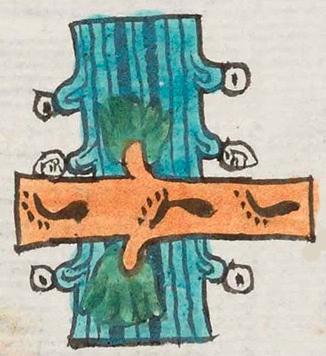Cuauhpanoayan (Mdz10r)
This compound glyph for the place name Cuauhpanoayan includes three principal elements, a tree, a river, and a set of footprints. One consists of a tree [from cuahuitl) and providing the stem "cuauh"). In this bird's eye view, the tree or tree trunk is lying on its side, creating a bridge for crossing over {panoa) the water below. Three alternating footprints appear on the tree trunk to show the motion of crossing. The locative suffix -yan is not visible, but it may be represented semantically by the landscape features of the compound. The tree has the usual terracotta-colored bark and two-tone green foliage. The water is a typical turquoise blue with black lines of current (two of them especially thick down the middle), plus white turbinate shells and white droplets/beads splashing off the flow.
Stephanie Wood
The footprints going over the make-shift bridge provide a suggestion of the verb, panoa. The locative suffix -yan is one that attaches to verbs and indicates customary action. [Frances Karttunen, "Critique of glyph catalogue in Berdan and Anawalt edition of Codex Mendoza," unpublished manuscript.] So, it would be a place where the the crossing over (on the wooden bridge) would occur customarily. In fact, Tezozomoc (1598) refers to the bridge at Cuauhpanoayan. (See: Gran Diccionario del Náhuatl, https://gdn.iib.unam.mx/diccionario/cuauhpanoayan/174842.]
Footprint glyphs have a wide range of translations. In this collection, so far, we can attest to yauh, xo, pano, -pan, paina, temo, nemi, quetza, otli, iyaquic hualiloti, huallauh, tetepotztoca, totoco, -tihui, and the vowel "o." Other research (Herrera et al, 2005, 64) points to additional terms, including: choloa, tlaloa, totoyoa, eco, aci, quiza, maxalihui, centlacxitl, and xocpalli.
Stephanie Wood
quauhpanoayan puo
Cuauhpanoayan, pueblo
Stephanie Wood
c. 1541, or by 1553 at the latest
Stephanie Wood
bridges, puentes, huellas de pie, footprints, icximachiyotl, xocpalli, icxipamitl, river, río, Cuauhpanohuayan, Quauhpanoayan, Quauhpanohuayan, nombres de lugares

cuahui(tl), tree, https://nahuatl.wired-humanities.org/content/cuahuitl-1
panoa, to cross over (verb), https://nahuatl.wired-humanities.org/content/panoa
-yan (locative suffix), https://nahuatl.wired-humanities.org/content/yan
"Wooden Bridge" [Frances Karttunen, unpublished manuscript, used here with her permission.]
"Place Where the Water is Crossed by a Wooden Bridge" (Berdan and Anawalt, 1992, vol. 1, 201)
"La Puente de Madera" (donde la gente cruza regularmente)
Stephanie Wood
Codex Mendoza, folio 10 recto, https://digital.bodleian.ox.ac.uk/objects/2fea788e-2aa2-4f08-b6d9-648c00..., image 30 of 188.
The Bodleian Libraries, University of Oxford, hold the original manuscript, the MS. Arch. Selden. A. 1. This image is published here under the UK Creative Commons, “Attribution-NonCommercial-ShareAlike 3.0 License” (CC-BY-NC-SA 3.0).


